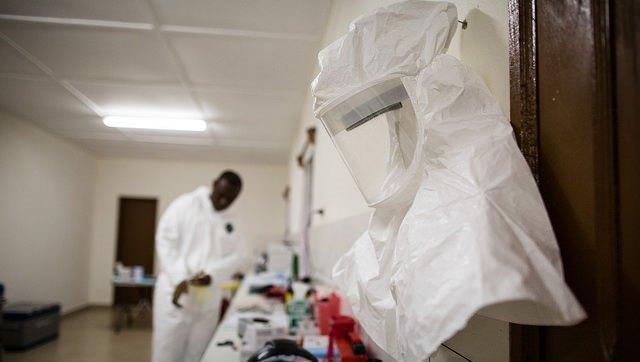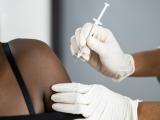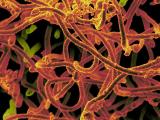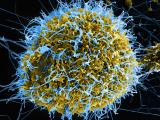The World Health Organization (WHO) today cleared a rapid test for Ebola infection for use in outbreak countries, an antigen test that can produce a result in 15 minutes, compared with nucleic acid methods that take from 12 to 24 hours.
Lab testing for Ebola is one of the keys for aggressively detecting cases, isolating infected patients, and guiding clinical decisions.
The action follows the WHO's November announcement of new initiatives to speed the development of Ebola rapid tests, which included putting an emergency assessment mechanism in place to review rapid test submissions. When the measures were unveiled, an expert group was reviewing 5 of 16 submissions the WHO had received.
Test offers advantages for low-resource settings
The ReEBOV Antigen Rapid Test, made by US-based Corgenix, is based on detection of Ebola protein rather than on nucleic acid methods used by commercial and in-house tests, the WHO said. Though the nucleic acid tests (NATs) are more accurate, they require well-established labs and fully trained personnel, it added.
When compared with an Ebola NAT previously listed by the WHO, the rapid test correctly identified 92% of infected patients and 85% of those not infected with the virus.
Though less accurate, the rapid test is easy to perform and doesn't require electricity, an important consideration in lower-level health facilities or mobile units in remote locations. The WHO said when possible, rapid test results should be confirmed with an approved Ebola NAT.
Getting Ebola response RITE in Liberia
Meanwhile, a strategy developed by the US Centers for Disease Control and Prevention (CDC) and Liberia's health ministry to address the exponential rise in Ebola cases last October helped drive down the number of infections, according to an analysis of outbreaks that occurred around the time the system was deployed. Researchers from the CDC, Liberia's health ministry, the WHO, the United Nations, and the African Union reported their findings today in an early online edition of Morbidity and Mortality Weekly Report (MMWR).
The Rapid Isolation and Treatment of Ebola (RITE) strategy consisted of investigation and response teams that were assembled in advance to deploy to remote regions as soon as notification of Ebola was received. The groups coordinated assistance from the health ministry and international responders and had the capacity and supplies on hand to isolate and treat patients by putting up facilities or taking patients to existing Ebola treatment units, collecting and transporting blood samples, tracking transmission chains, training burial teams, and following contacts.
Responders launched the RITE strategy in early October. In November the program started providing RITE kits for rapid delivery to affected counties. Those included supplies needed for the first 14 days of the outbreak such as oral rehydration solution, antimalarial drugs, antibiotics, personal protective equipment (PPE), and materials to build temporary isolation and treatment units.
When researchers compared six outbreaks that began before the strategy with six that started after, they found that the later ones lasted less than half as long, had lower mortality rates and shorter transmission chains, and nearly tripled the number of patients who were isolated and treated.
The MMWR report and an accompanying CDC press release included dramatic photos depicting difficult conditions RITE teams encountered when reaching some of the remote communities, including muddy and nearly impassable roads and difficult and dangerous river crossings. Another photo showed tents RITE members stayed in while doing outbreak investigations in the field.
In a press release today, the CDC said the RITE strategy is now being used in Sierra Leone and Guinea.
CDC director Tom Frieden, MD, MPH, said in the statement, "Whether it's traveling by air, jeep, canoe, or walking many miles on foot to find every case of Ebola, the RITE teams are helping Liberia get closer to zero cases than ever before." He added, "It's critical that we continue to support these teams—and to expand their work into Sierra Leone and Guinea to help to get the epidemic under control there as well."
Other developments
- The number of confirmed, probable, and suspected Ebola infections in the outbreak region has climbed to 23,371, including 9,365 deaths, the WHO said today. The case number reflects increases of 153 illnesses and 77 deaths since the WHO's full epidemiologic report on the outbreak on Feb 18. Today's totals reflect cases reported through Feb 18 in Guinea, Feb 17 in Sierra Leone, and Feb 16 in Liberia.
- The WHO yesterday wrapped up a 3-day meeting in Geneva with foreign medical teams that assisted with the Ebola response to talk about what more can be done to get the three hardest hit countries to zero cases, to hear technical updates on clinical topics, and to discuss how teams might play a role in getting health systems functioning again. At a media briefing yesterday, the WHO said the meeting drew 160 participants from the 40 different organizations that sent medical teams to help with the Ebola outbreak. During the media briefing, officials from the WHO and other response groups praised the frontline health workers from the three affected countries and lauded the courageous response of health workers from other countries that came to help. Jeremy Konyndyk, director of foreign disaster assistance for the US Agency for International Development (USAID) said that in August and September when cases were rising exponentially it wasn't clear how the international medical response would come together. Unlike in other types of disaster response, such as for tsunamis and earthquakes, "There were no modular components that we could take off the shelf and send out." He said months of hard work lie ahead in getting the countries to zero cases. "We're not going to take our foot off the gas pedal until we are there."
- The CDC yesterday released a toolkit for training healthcare workers to serve in Ebola treatment units in Africa. Based on its 3-day training course, it includes content from similar courses developed by Doctors without Borders (MSF) and the WHO and incorporates CDC guidelines on infection prevention and control. The toolkit includes training materials, templates, and videos. The CDC is also offering planning materials to help groups offer the training course, with guidance on physical space, setup, supplies, and staffing.
See also:
Feb 20 WHO press release
Nov 18, 2014, CIDRAP News story "WHO plans to speed development of Ebola rapid test"
Feb 20 WHO update
Feb 20 CDC press release
Feb 20 MMWR early release report
Feb 19 WHO media briefing audiofile

















